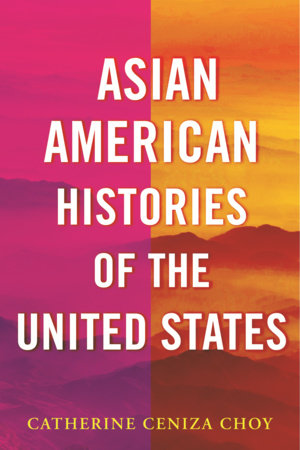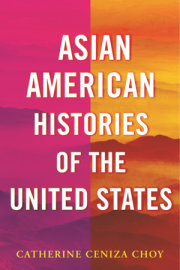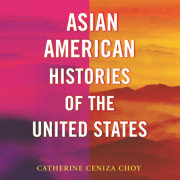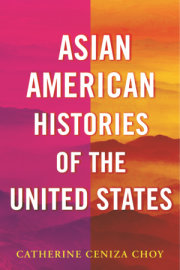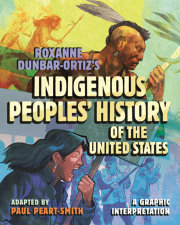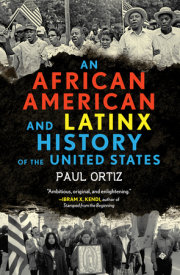Catherine Ceniza Choy
Beacon Press Boston
Introduction
The multiple Origins
Of asian american historiesWHen and where does an Asian American history of the United States begin? There is no singular origin story that begins in one time
And one place and then progresses forward smooth like silk, linear like thread. Rather, the origins of Asian American history are multiple.
Asian American history begins in the here and now, as well as over 150 years ago in the mid-nineteenth century. It begins in Asian continen- tal lands and waterways as well as in urban, suburban, and rural areas of the United States. The Asian American experience stretches back as well as forward in time and space. It crisscrosses over time periods and over lands, oceans, and waterways. Where and when we enter are complex questions.
Like a galaxy of stars, the multiple origins of Asian American his- tory are distinctive, but most meaningful when collectively visible as in a constellation, revealing intricate connections that present new ways of seeing, understanding, and moving forward. Sadly, these origins have been erased, obscured, and forgotten in traditional histories of the United States. Yet, by calling attention to them, they shine brightly again.
Asian American history helps us remember.
Asian American History Begins in 2020 with the creation of the Stop AAPI Hate reporting center, and the research finding that Filipino nurses in the United States suffered a disproportionate and devastating toll from COVID-19. The Stop AAPI Hate reporting center launched on
1 March 19, 2020, in response to the alarming escalation of anti-Asian coronavirus-related harassment and violence.1 On September 28, 2020, National Nurses United, the largest union of registered nurses, released a report with the finding that 31.5 percent of registered nurses who died from COVID-19 were Filipino American, although the group makes up only 4 percent of this labor force.2
These current events are better understood in historical context. The present-day association of Asian bodies with disease is not new. Asian American history illuminates that it is just the most recent example in a long-standing history of racializing Asians as disease carriers, beginning with blaming Chinese immigrants for smallpox outbreaks in the second half of the nineteenth century. The presence of Filipino nurses on the front lines of American hospitals is also not new, but rather part of a six-decades-long history of their mass migration to the United States to alleviate critical nursing shortages. Since the 1960s, Filipino American nurses have worked on the front lines of major disease outbreaks includ- ing the AIDS epidemic and SARS.
One new aspect of this contemporary history is the large number of Asian American healthcare workers in the United States, some of whom have experienced anti-Asian hostility because of coronavirus-related rac- ism. In April 2020,
Time magazine recognized Dr. Chen Fu, a hospitalist at NYU Langone Medical Center, in its series entitled “Heroes of the Front Lines.” Dr. Fu pointed out this dilemma: “As an Asian-American doctor, it’s tough to reconcile being both celebrated and villainized at the same time.”3
Asian American History Begins in 1975 with the journeys of Southeast Asian refugees from Vietnam, Laos, and Cambodia across land-based regions and rivers of Southeast Asian nations, and subsequently across all fifty states of the United States in their resettlement. US involvement in the Vietnam War and the “Secret War” in Laos placed the lives of their Southeast Asian allies at risk. Thus, many Southeast Asian Americans are here in the United States because Americans were there.
Although US government secrets obscured Southeast Asian Ameri- can histories, refugees and their descendants indelibly shaped the late-
Twentieth-century American landscape through the building of Little Saigons, the creation of small businesses from Vietnamese nail salons to Cambodian donut shops, and the preservation of their stories through literature and the performing arts in organizations such as the Diasporic Vietnamese Artists Network in California and the Angkor Dance Troupe in Massachusetts.
The history of Southeast Asian American refugees is dynamic. In the twenty-first century, the numbers of refugees from Burma and Bhutan, fleeing political and social persecution and discrimination in their home countries, dramatically increased. They composed the two largest refugee groups arriving in the United States in 2011. Many have resettled in the American South.4
Asian Americ An History Begins in 1968 with the emergence of the Asian American Movement and its solidarity with the Third World Liberation Front. On November 6, 1968, a coalition of student groups, including Black, Asian American, Chicano, and American Indian students, went on strike at San Francisco State College to demand institutional change. Another strike erupted on the University of California, Berkeley campus on January 21, 1969.
Their demands, their political consciousness, and even the language that they used to identify themselves were new. In 1968, UC Berkeley graduate students Emma Gee and Yuji Ichioka used the term “Asian American” for the first time when they founded the Asian American Po- litical Alliance in Berkeley.5 To identify as Asian American heralded a new political sensibility that brought together different groups of people of Asian descent under one larger umbrella, distinct from previous ties defined by Asian country of origin, region, or hometown.
From the late 1960s to the 1980s, the Asian American Movement was a social movement for racial justice that led to the establishment of Asian American social services, arts organizations, and historical societies as well as curricular innovation. One of its major legacies was the creation of San Francisco State University’s Department of Asian American Stud- ies and UC Berkeley’s Asian American and Asian Diaspora Studies Pro- gram. The demand for Asian American studies, the academic discipline
That examines Asian American history, culture, and contemporary issues, reverberated across the United States. It resulted in the creation of de- partments, programs, and course offerings at the Claremont Colleges; the University of Texas, Austin; the University of Minnesota, Twin Cit- ies; Oberlin College; the University of Illinois, Urbana-Champaign; the University of Maryland, College Park; Williams College; Binghamton University; New York University; and more. It lives on in the continuing struggles for Asian American studies in higher education as well as the K–12 curriculum.
Asian American History Begins in 1965 with the passage of the Hart- Celler Act, also known as the Immigration and Nationality Act of 1965. The 1965 Act created a more equitable ceilings system of immigration by giving countries throughout the world the same number of immigrant vi- sas. In doing so, it was a major break from the United States’ previous national origins system of immigration that had been in place since 1924. That system was overtly discriminatory, favoring immigration from north- ern and western Europe and virtually abolishing immigration from Asia. In the 1960s, American legislators did not foresee how the Hart-Celler Act would greatly increase Asian immigration. Yet, that is what it did.
Exponential growth would become one of the defining features of post-1965 Asian America, with immigration its driving force. For exam- ple, the Korean immigrant population grew from just 11,000 in 1960 to 290,000 in 1980, marking a 2,500 percent increase.6 The Pakistani immigrant population also grew exponentially, from 30,000 in 1980 to 273,000 in 2015.7 Increasing ethnic diversity would be another distinc- tive feature of post-1965 Asian America. The record 23 million people who trace their roots to more than twenty countries in East and South- east Asia, and the Indian subcontinent, contribute to Asian Americans’ incredible heterogeneity.8
The Immigration Act of 1965 established a preference system that de- termined visa allocation. While most of the preferences facilitated family reunification, others favored the immigration of professionals and work- ers with needed skills. Hence, the socioeconomic diversity of Asian immi-
Grants also increased, with many of the immigrants being highly skilled and educated. While this diversity fueled stereotypes of Asian Americans as whiz kids and model minorities, it is more accurate to characterize post-1965 Asian immigration as having a dual nature. While many Asian immigrants were highly educated, many others were not. This socioeco- nomic diversity is illustrated by the prevalence of Asian American labor in the technology and healthcare industries as engineers and physicians, as well as in the beauty and food industries as nail salon and restaurant workers.
Asian American History Begins in 1965 with Filipino American agri- cultural workers and labor leaders initiating the Delano Grape Strike on September 8, 1965. The impact of the five-year strike was profound. It catalyzed the modern farmworkers’ movement for fair wages, the right to organize, and the recognition of the dignity of their labor.
The United Farm Workers (UFW) emerged from the joined forces of the Agricultural Workers Organizing Committee, which was predomi- nantly Filipino American, and the National Farm Workers Association, which was mostly Mexican American. Yet, while Mexican American la- bor leaders, most notably Cesar Chavez, and the participation of Mexi- can American farmworkers became more well known, the formative role played by Filipino American labor leaders, such as Larry Itliong, in the Delano Grape Strike has been for the most part overlooked.
In the 1960s, Filipino American agricultural labor organizing was not new, but rather a continuation of their decades-long struggle to be recognized and treated as fellow human beings throughout the first half of the twentieth century. Thus, while the 1965 grape strike provides a useful starting point regarding how various Asian American groups have organized throughout the twentieth century and into the twenty-first, it raises critical questions about how and why Asian American activists have become forgotten. This origin story also presents an opportunity to showcase how more recent work by historians like Dawn Bohulano Mabalon and legislators like Rob Bonta have created new ways to re- member Asian American activists.
Asian American History Begins in 1953 with the international and trans- racial adoption of Asian children by American families. The plight of mixed race children born of Japanese and Korean women and American soldiers was the catalyst for this phenomenon. It transformed the United States into an international adoption nation.
In the 1950s and 1960s, many Asian international adoptees were iso- lated, oftentimes the only people of Asian descent in midwestern and rural areas. Yet, they are part of a longer US history of Asian Ameri- can interracial unions and the regulation of interracial intimacies. This history includes Chinese-Irish marriages in the Northeast in the 1800s as well as nineteenth- and twentieth-century anti-miscegenation laws barring marriages between Asians and whites in many states. However, even during times of discrimination, interracial marriages were formed with couples getting married at sea or traveling to other states to evade anti-miscegenation laws.
International and transracial adoption, and interracial romances of the nineteenth to the mid-twentieth century were precursors to the in- credible heterogeneity of the Asian American population today. This diversity includes mixed race individuals who identify with multiple racial and ethnic categories. Often dismissed as incomplete, multiracial peoples’ wholeness deserves recognition, as noted in the 1993 Bill of Rights for People of Mixed Heritage, authored by clinical psychologist Maria P. P. Root.
Asian American History Begins in 1942 with the incarceration of 120,000 Japanese Americans in internment camps. Their incarceration took place without due process. Approximately two-thirds of the Japa- nese American internees were US-born. Most Americans know the date of December 7, 1941, “a date which will live in infamy,” because of Japan’s bombing of Pearl Harbor and President Franklin D. Roosevelt’s speech the day after the attack. However, we should also remember Feb- ruary 19, 1942, the date that President Roosevelt issued Executive Order 9066. It led to the forced removal of Japanese Americans from the West Coast to assembly centers and subsequently their incarceration in in- ternment camps in remote areas of California, Arizona, Colorado, Utah,
Arkansas, Wyoming, and Idaho. Racism and wartime hysteria fueled this denial of justice.
World War II was also a period of revolutionary changes for specific groups of Asian Americans as a result of wartime needs and US alliances with China, the Philippines, and India. These Asian Americans availed themselves of new employment opportunities, enlisted in the US military, and became Rosie the Riveters. These groups also gained US naturaliza- tion rights. Despite these progressive changes and geopolitical distinc- tions, the racial lumping together of Asian Americans resulted in their unequal treatment in the form of anti-Asian harassment and violence.
The impounding of over one hundred of Dorothea Lange’s photo- graphs of the evacuation and internment of Japanese Americans con- cealed a visual critique of this history. In the 1980s, Japanese American internees would bear witness, share their stories, and demand an apology and redress. They would work against the amnesia regarding this grave injustice and toward remembrance.
Asian American History Begins in 1919 with Korean delegates gather- ing in Philadelphia, the “cradle of liberty.” They wanted the American people to know that on March 1, Koreans in Seoul had declared their independence from Japan. This history illuminates the imperial origins of Asian America, forged at the intersection of multiple empires—in this case, that of Japan and the United States. By the late nineteenth and early twentieth centuries, both nations had emerged as world powers through imperial expansion. In the second half of the nineteenth century, Japan colonized Hokkaido and Okinawa. Its imperial ambitions expanded and included colonizing Korea from 1910 to 1945. Although the Korean del- egates appealed to American values of liberty and freedom, the United States was building an empire of its own. The nineteenth-century ideol- ogy of Manifest Destiny justified white American westward expansion across the North American continent and the Pacific Ocean. Hence, early Korean American history intersects with the histories of Filipino immi- grants who migrated to the United States as a consequence of US annex- ation of the Philippines as well as the histories of Indian immigrants who fled British domination.
While Korean immigrant pioneers were relatively few in number, their impact on Korean independence was substantive. In Hawai‘i and the US mainland, Korean immigrants coordinated an independence movement composed of no fewer than twenty-four organizations seeking to free Ko- rea. A prominent immigrant pioneer was Korean independence activist Ahn Chang Ho, who is considered one of Korea’s most important philo- sophical leaders of the twentieth century. After immigrating to the United States with his wife in 1902, he established mutual aid societies and polit- ical organizations to fight for Korean independence. In the 1910s, he left his family in California in order to campaign for independence and help establish the Korean Provisional Government in Shanghai. He passed away in Korea on March 10, 1938, after having been arrested and tor- tured multiple times by the Japanese for his activism.
Other Korean immigrant pioneers and independence activists were unable to return to their Korean homeland. However, the Korean gov- ernment officially recognized some of them as patriots and re-interred their remains in Korean national cemeteries. One of these patriots, Choi Neung-ik, who is my husband’s paternal grandfather, is now buried in Daejeon National Cemetery. In the United States, this history lives on today through the work of the patriots’ descendants. They include Ralph Ahn, the youngest son of Ahn Chang Ho, who sustains this his- tory through newsletters and gatherings of the Korean American Pioneer Descendants Society.
Asian American History Begins in 1875 with the Page Act, the US im- migration law that prohibited the recruitment of unfree laborers and women for “immoral purposes.” Although the law focused on the impor- tation of prostitutes, it was enforced primarily against Chinese women. The Page Act illuminates a history of the United States, not as a nation of immigrants but rather increasingly more like a fortress. It was only the first of many federal immigration laws that were used to keep Asians out of the United States.
Another troubling legacy of the Page Act is the objectification of Asian and Asian American women that persists to this day. It is most visible through the history of stereotypes of Asian women on-screen as
Dragon ladies, lotus blossoms, and prostitutes. However, these popular representations have affected the real-life experiences of Asian Ameri- can women in dangerous ways, making them targets of harassment and violence. Current congressmembers such as Representatives Judy Chu, Grace Meng, and Marilyn Strickland challenge these one-dimensional portrayals by breaking barriers in politics and by working to address inequities in Asian American and women’s histories, among other areas.
Asian American History Begins in 1869 with the completion of the first transcontinental railroad in the United States. Connecting the Eastern Seaboard with the Pacific Coast, this event heralded US national progress and ingenuity. Chinese railroad workers constituted the bulk of the la- bor of the Central Pacific Railroad. They worked through harsh winters and mountainous passages, using dangerous tools and placing their lives at risk.
In one of the starkest examples of the erasure of Asian American con- tributions to US history, Chinese railroad workers were excluded from the photograph celebrating the joining of the Central Pacific and Union Pacific railroads in 1869 at Promontory Summit in Utah. Their exclusion was accompanied by increasing anti-Chinese hostility in the American West, expressed in the violent expulsion of Chinese from cities and rural areas and in discrimination in courts of law. This hostility had emerged soon after the onset of Chinese mass migration to seek gold in Northern California after its discovery in Sutter’s Mill in 1848.
In 2014, photographer Corky Lee resisted this erasure of Chinese labor by taking a photograph of Asian Americans, including descendants of the Chinese railroad workers, at Promontory Summit on the 145th anniversary of the transcontinental railroad’s completion.
The impact of this erasure runs deep. Over time, erasure would form an Asian American historical pattern. Tragically, it informs the present-day surge in anti-Asian violence across the United States beginning in 2020 and continuing in the first few months of 2021. The rise of verbal and physical harassment and violence against Asian American elders and
Women illustrates that this violence is tinged with the vulnerability of age and gender, factors that intersect with racist scapegoating in the age of COVID-19.
Beginning in March 2020 and throughout the remainder of the year, President Donald Trump and other high-ranking US politicians referred to COVID-19 as the “China virus” and, jokingly, as the “kung flu.” For Asian Americans, however, it is no laughing matter. For us, it can be and has been a matter of life and death.
Thus, Asian American histories of the United States matter. Anti-Asian violence is a violence with a history. It is an outcome of a longer pattern of Asian Americans being treated as expendable objects. This is poi- gnantly expressed in the ways many Americans do not see us as a central part of US history.
And so Asian American activists, artists, and scholars do the work that we do in order to fight against dehumanization. We document and preserve, imagine and create, research and write our histories and hu- manity into being.
Copyright © 2022 by Catherine Ceniza Choy. All rights reserved. No part of this excerpt may be reproduced or reprinted without permission in writing from the publisher.

